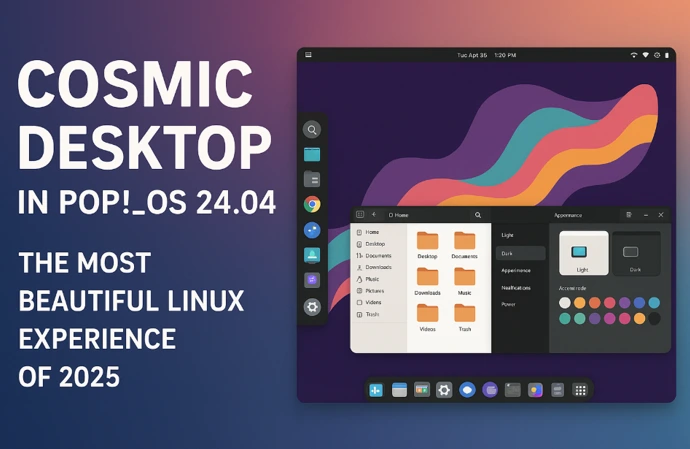
Quantum-Ready Linux: The Future of Open-Source Computing
The world of computing is on the cusp of a revolution, and at the heart of this transformation is quantum computing. Unlike classical computers, which rely on bits to process information in binary (0s and 1s), quantum computers leverage the principles of quantum mechanics—superposition, entanglement, and quantum tunneling—to perform computations at unprecedented speeds. As quantum technology advances, the need for software ecosystems to support it becomes critical. Enter Quantum-Ready Linux, an emerging paradigm in open-source computing that promises to bridge the gap between classical and quantum systems, ensuring that Linux remains at the forefront of technological innovation.
In this blog post, we’ll explore what Quantum-Ready Linux means, why it’s vital for the future of open-source computing, and how the open-source community is shaping this exciting frontier. We’ll dive into the latest developments, tools, and initiatives, drawing from recent data and official sources to provide a comprehensive and human-written guide that’s both informative and SEO-optimized.
What is Quantum-Ready Linux?
Quantum-Ready Linux refers to Linux-based operating systems, tools, and frameworks optimized to support quantum computing workloads, either directly or through hybrid classical-quantum architectures. Linux, with its open-source nature and dominance in high-performance computing (HPC), is uniquely positioned to serve as the backbone for quantum computing infrastructure. Quantum-Ready Linux integrates quantum programming frameworks, libraries, and hardware interfaces, enabling developers to build, simulate, and execute quantum algorithms seamlessly.
The term “quantum-ready” doesn’t imply that Linux distributions are running quantum computers directly (quantum hardware is still specialized and distinct). Instead, it means Linux is evolving to support quantum development environments, provide access to quantum processing units (QPUs) via cloud platforms, and facilitate post-quantum cryptography to secure systems against quantum threats. This adaptability ensures Linux remains relevant in a future where quantum computing reshapes industries like cryptography, artificial intelligence, and drug discovery.
Why Quantum-Ready Linux Matters
1. Linux’s Dominance in High-Performance Computing
Linux powers 462 of the world’s top 500 supercomputers, according to recent reports, making it the de facto operating system for HPC. Quantum computing, with its potential to solve complex problems exponentially faster than classical systems, is a natural extension of HPC. As quantum computers scale, Linux’s flexibility, scalability, and open-source ethos make it the ideal platform to integrate quantum and classical computing workflows.
2. The Rise of Quantum Computing
Quantum computing is no longer a theoretical concept. Companies like IBM, Google, D-Wave, and QuEra are pushing the boundaries with commercial quantum systems. For instance, Pasqal’s 140-qubit neutral-atom quantum system, deployed under the EuroHPC JU contract in 2025, highlights the rapid progress in quantum hardware. To harness this power, developers need robust software ecosystems, and Linux is stepping up to meet this demand.
3. Post-Quantum Cryptography
Quantum computers pose a threat to classical encryption methods like RSA, which rely on problems (e.g., prime factorization) that quantum algorithms, such as Shor’s algorithm, can solve efficiently. Quantum-Ready Linux is at the forefront of adopting post-quantum cryptography (PQC), ensuring that open-source systems remain secure in a quantum future. Initiatives like the Open Quantum Safe (OQS) project, part of the Linux Foundation’s Post-Quantum Cryptography Alliance, are integrating PQC algorithms into Linux-based software.
4. Open-Source Collaboration
The open-source model has driven innovation in classical computing, with projects like Linux and OpenStack as prime examples. Quantum computing benefits from the same collaborative spirit. Open-source quantum frameworks like Qiskit, Cirq, and QuTiP, which run seamlessly on Linux, democratize access to quantum tools, fostering a global community of developers and researchers.
Key Components of Quantum-Ready Linux
To understand how Linux is becoming quantum-ready, let’s break down the key components that make this possible.
1. Quantum Programming Frameworks
Quantum programming frameworks are the bridge between developers and quantum hardware. These tools, many of which are open-source and Linux-compatible, allow developers to write quantum algorithms and simulate them on classical systems or execute them on QPUs. Some of the most prominent frameworks include:
- Qiskit: IBM’s open-source software development kit (SDK) for quantum computing, Qiskit is the world’s most popular quantum framework. It supports circuit building, transpilation, and execution on IBM’s quantum hardware and third-party providers like Alpine Quantum Technologies (AQT) and IonQ. Qiskit runs natively on Linux, with options for local installation or cloud-based Jupyter Notebooks in IBM Quantum Lab.
- Cirq: Developed by Google Quantum AI, Cirq is designed for noisy intermediate-scale quantum (NISQ) algorithms. It integrates with Linux-based tools like qsim, a C++ simulator that can handle up to 40 qubits on high-end workstations.
- QuTiP: The Quantum Toolbox in Python (QuTiP) is an open-source library for simulating open quantum systems. Built on NumPy, SciPy, and Cython, QuTiP is widely used in quantum optics and quantum information research and is fully compatible with Linux.
- PennyLane: This framework focuses on quantum machine learning and hybrid quantum-classical algorithms. It integrates with Cirq and other tools, making it a versatile choice for Linux-based quantum development.
These frameworks leverage Linux’s robust ecosystem, including Python, C++, and Julia, to provide developers with flexible and powerful tools for quantum programming.
2. Hybrid Quantum-Classical Architectures
Quantum computers are not standalone systems; they rely on classical computers for tasks like algorithm design, error correction, and result interpretation. Quantum-Ready Linux supports hybrid architectures that combine classical CPUs/GPUs with QPUs. For example:
- Qiskit Runtime: This service optimizes quantum workloads by orchestrating computations across CPUs, GPUs, and QPUs in the cloud. It’s designed to run on Linux-based platforms, ensuring seamless integration with existing HPC infrastructure.
- qBraid: A cloud platform for quantum software development, qBraid provides single-command access to CPUs, GPUs, and QPUs. Its Linux-based Lab IDE includes preconfigured environments for quantum tutorials, making it accessible for beginners and experts alike.
Hybrid algorithms, which split tasks between classical and quantum processors, are a key trend in quantum programming. Linux’s ability to handle these complex workflows makes it indispensable.
3. Post-Quantum Cryptography Integration
The threat of quantum computers breaking classical encryption has spurred the development of PQC algorithms. Quantum-Ready Linux is adopting these algorithms to secure systems and data. The Open Quantum Safe (OQS) project, a flagship initiative under the Linux Foundation, provides a C library (liboqs) for quantum-resistant cryptographic algorithms and integrates them into tools like OpenSSL and OpenSSH.
Recent developments, such as ETSI’s 2025 standard for hybrid quantum-safe key encapsulation mechanisms (Covercrypt), highlight the urgency of PQC adoption. Linux distributions like Red Hat Enterprise Linux (RHEL) are working with partners like QuSecure to implement PQC, ensuring enterprises can protect sensitive data against future quantum threats.
4. Quantum Hardware Interfaces
Quantum-Ready Linux supports interfaces to quantum hardware from vendors like IBM, D-Wave, and Pasqal. For example:
- IBM Quantum Platform: Qiskit provides an interface to IBM’s quantum computers, allowing Linux users to run circuits on real QPUs via the cloud.
- D-Wave Ocean: D-Wave’s suite of tools, including dwave-cloud-client and dwave-system, enables Linux users to access D-Wave’s quantum annealers for optimization problems.
- Pasqal and QuEra: These neutral-atom quantum systems can be programmed using Linux-compatible frameworks like Cirq, with support for cloud-based execution.
These interfaces ensure that Linux remains a universal platform for accessing diverse quantum hardware.
Linux Distributions with Quantum-Ready Features
Several Linux distributions are leading the charge in becoming quantum-ready by preconfiguring environments with quantum programming frameworks, libraries, and tools. Below are some notable examples that come with quantum-ready capabilities out of the box or with minimal setup:
1. Ubuntu
Ubuntu, one of the most popular Linux distributions, is a go-to choice for quantum computing due to its robust support for Python-based frameworks like Qiskit, QuTiP, and PennyLane. Canonical, Ubuntu’s parent company, has partnered with quantum computing initiatives to ensure compatibility with cloud-based quantum platforms like IBM Quantum and qBraid. Ubuntu’s Software Center includes prebuilt packages for quantum development, and its active community provides tutorials for setting up quantum environments.

- Quantum-Ready Features: Preinstalled Python 3, pip, and Jupyter Notebook; native support for Qiskit and Cirq; compatibility with IBM Quantum Lab.
- Best For: Beginners and developers looking for an accessible, user-friendly platform.
2. Fedora
Fedora, sponsored by Red Hat, is known for its cutting-edge features and enterprise-grade stability. Fedora Workstation includes development tools for quantum programming, such as Anaconda, which simplifies the installation of Qiskit, QuTiP, and other libraries. Fedora’s collaboration with Red Hat ensures early adoption of post-quantum cryptography standards, making it a secure choice for quantum-ready applications.
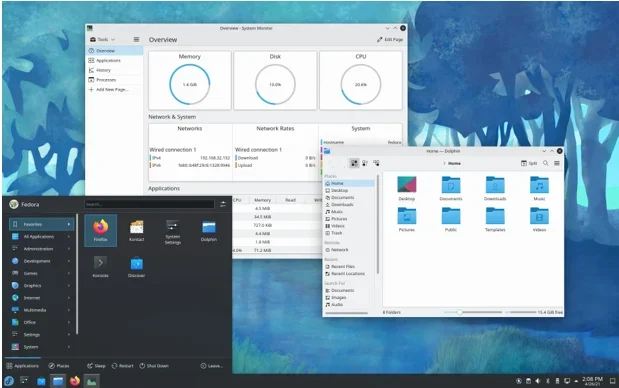
- Quantum-Ready Features: Built-in support for Anaconda and Python-based quantum frameworks; early integration of PQC libraries like liboqs; optimized for HPC environments.
- Best For: Enterprise users and researchers requiring stability and security.
3. Debian
Debian’s versatility and extensive package repository make it a favorite for quantum developers. The Debian Science Team maintains packages for quantum computing tools, including QuTiP and Qiskit, ensuring seamless installation. Debian’s lightweight nature allows it to run on HPC clusters and cloud environments, making it ideal for quantum simulations and hybrid workflows.
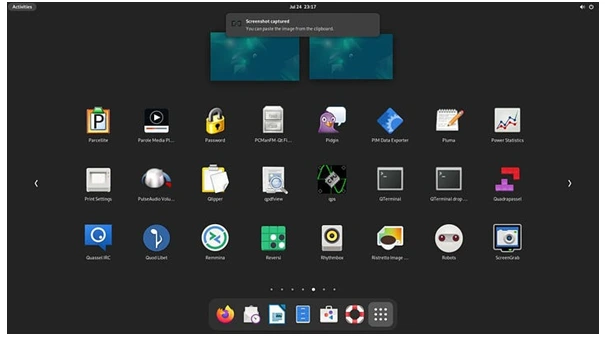
- Quantum-Ready Features: Extensive package support for quantum libraries; compatibility with qsim and other simulators; lightweight for cluster deployments.
- Best For: Advanced users and HPC environments.
4. Arch Linux
Arch Linux, with its rolling-release model and minimalist approach, appeals to developers who want full control over their quantum-ready setup. While it requires manual configuration, Arch’s AUR (Arch User Repository) includes packages for Qiskit, Cirq, and QuTiP, and its flexibility allows users to optimize their systems for quantum workloads.
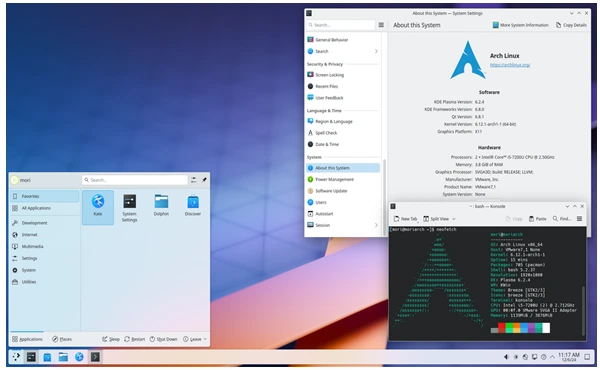
- Quantum-Ready Features: AUR packages for quantum frameworks; customizable for performance-critical applications; supports bleeding-edge updates.
- Best For: Power users and developers who prefer a DIY approach.
5. openSUSE
openSUSE, with its focus on enterprise and research applications, offers robust support for quantum computing through its Tumbleweed (rolling release) and Leap (stable release) editions. openSUSE’s YaST configuration tool simplifies the setup of quantum development environments, and its integration with Open Build Service ensures access to the latest quantum libraries.
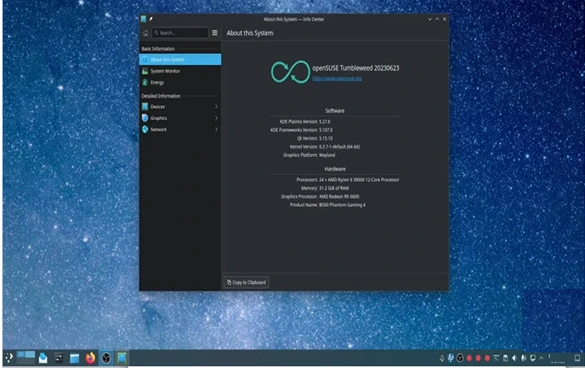
- Quantum-Ready Features: YaST-based setup for quantum tools; support for Qiskit and PennyLane; optimized for research and enterprise use.
- Best For: Research institutions and enterprise deployments.
These distributions provide a starting point for quantum-ready computing, but developers can enhance any Linux distribution with quantum capabilities by installing frameworks like Qiskit or Cirq via pip or conda. Cloud-based platforms like qBraid also offer preconfigured Linux environments, eliminating the need for local setup.
The Role of Open-Source in Quantum-Ready Linux
Open-source software is the lifeblood of Quantum-Ready Linux. The collaborative nature of open-source development accelerates innovation, improves accessibility, and ensures reproducibility—key tenets of scientific and commercial progress. Here’s how open-source is shaping the quantum-ready future:
1. Democratizing Access
Open-source frameworks like Qiskit, Cirq, and QuTiP are freely available, lowering the barrier to entry for quantum computing. Platforms like qBraid and IBM Quantum Lab provide cloud-based environments where Linux users can experiment with quantum algorithms without needing specialized hardware. This democratization fosters a global community of developers, from students to industry professionals.
2. Enhancing Collaboration
The open-source model encourages collaboration across academia, industry, and government. The Open Quantum Design (OQD) project, for instance, aims to build the world’s first open-source, full-stack quantum computer using trapped-ion technology. Licensed under Apache 2.0, OQD promotes transparency and collaboration on hardware, software, and APIs.
Similarly, the Post-Quantum Cryptography Alliance (PQCA), launched by the Linux Foundation in 2024, brings together giants like AWS, Google, and IBM to develop PQC standards and libraries. The PQCA’s Open Quantum Safe project is a cornerstone of this effort, with active contributions on GitHub.
3. Improving Documentation and Education
While open-source quantum projects excel in providing README files, user documentation remains a challenge. However, projects like Qiskit and QuTiP stand out for their comprehensive guides and tutorials, which are accessible on Linux platforms. Community-driven initiatives, such as Qiskit’s Slack channel and Cirq’s discussion forums, further enhance the learning experience.
Workshops, hackathons, and online courses organized by open-source communities are also critical. For example, QURECA’s partnership with IMPACTIFI in 2025 aims to bridge the gap between quantum education and industry readiness, leveraging Linux-based tools.
4. Driving Innovation
Open-source quantum software has led to breakthroughs in algorithm design and simulation. For instance, QuTiP’s efficient simulations of open quantum systems have advanced research in quantum optics and nanomechanical resonators. Similarly, Qiskit’s AI-driven transpiler service optimizes quantum circuits for hardware execution, pushing the boundaries of quantum performance.
Challenges and Opportunities
While Quantum-Ready Linux holds immense promise, it faces several challenges:
1. Scalability and Hardware Limitations
Quantum computers require extreme conditions (e.g., near-absolute-zero temperatures) and face scalability issues, with current systems limited to thousands of qubits. Linux-based simulators like Qiskit Aer and qsim help bridge this gap by enabling large-scale simulations, but fault-tolerant quantum systems remain a distant goal.
2. Documentation Gaps
Many open-source quantum projects lack comprehensive user documentation, making it difficult for newcomers to adopt them. Improving documentation and providing step-by-step tutorials will be critical for Quantum-Ready Linux to reach a broader audience.
3. Skill Shortage
Quantum computing requires specialized knowledge, and the global talent pool is limited. Open-source communities and educational initiatives must continue to train developers, leveraging Linux’s accessibility to lower the learning curve.
Opportunities
Despite these challenges, the opportunities are vast. Quantum-Ready Linux can:
- Lead in PQC Adoption: By integrating PQC algorithms, Linux can secure critical infrastructure against quantum threats.
- Support Emerging Use Cases: From drug discovery to financial modeling, Linux-based quantum tools can unlock new applications.
- Foster Global Collaboration: Open-source projects like OQD and PQCA can unite stakeholders to accelerate quantum innovation.
The Future of Quantum-Ready Linux
As quantum computing matures, Quantum-Ready Linux will play a pivotal role in shaping the future of open-source computing. Here are some trends to watch:
1. Integration with Quantum-Centric Supercomputing
IBM’s vision of quantum-centric supercomputing, which combines QPUs, CPUs, and GPUs, relies heavily on Linux-based platforms. Qiskit Runtime and similar services will drive this integration, enabling seamless execution of quantum workloads.
2. Expansion of Open-Source Hardware
Projects like Open Quantum Design are pioneering open-source quantum hardware, complementing Linux’s software ecosystem. This full-stack approach could democratize quantum computing further.
3. Growth of Quantum Education
Open-source communities will continue to drive quantum education through workshops, hackathons, and online resources. Linux’s role as a universal platform will make these initiatives accessible to a global audience.
4. Standardization of PQC
The PQCA and ETSI are setting the stage for standardized PQC algorithms, which will be integrated into Linux distributions like RHEL and Ubuntu, ensuring widespread adoption.
Conclusion
Quantum-Ready Linux is more than a buzzword; it’s a testament to the resilience and adaptability of open-source computing. By embracing quantum programming frameworks, hybrid architectures, and post-quantum cryptography, Linux is positioning itself as the cornerstone of the quantum era. The open-source community’s collaborative spirit, coupled with Linux’s dominance in HPC, ensures that Quantum-Ready Linux will drive innovation, democratize access, and secure the digital world against quantum threats.
As we stand on the brink of a quantum revolution, now is the time to engage with Quantum-Ready Linux. Whether you’re a developer, researcher, or enterprise leader, the tools and communities are ready to welcome you. Dive into Qiskit, explore QuTiP, or contribute to the Open Quantum Safe project—together, we can shape the future of open-source computing.
Disclaimer
The information provided in this blog post, “Quantum-Ready Linux: The Future of Open-Source Computing,” is for general informational purposes only. While we strive to ensure the accuracy and timeliness of the content, the field of quantum computing and related technologies is rapidly evolving, and some details may change after publication. The data, tools, and Linux distributions mentioned are based on the latest available information from official sources as of April 19, 2025.
This article is not intended as professional, technical, or investment advice. Readers are encouraged to conduct their own research and consult with qualified experts before making decisions related to quantum computing, software adoption, or cybersecurity measures, including post-quantum cryptography. The use of any software, tools, or platforms mentioned, including but not limited to Qiskit, Cirq, QuTiP, or specific Linux distributions, is at the user’s own risk.
The author and publisher are not affiliated with any of the companies, projects, or organizations mentioned (e.g., IBM, Google, Linux Foundation, or specific Linux distributions) unless explicitly stated. Any references to third-party products, services, or initiatives are for informational purposes and do not constitute an endorsement.
We are not responsible for any errors, omissions, or damages arising from the use of this information. Links to external websites or resources are provided for convenience, and we do not guarantee their accuracy or availability. By reading this article, you acknowledge that you understand and agree to these terms.
Ready to go quantum?
Stay tuned to techrefreshing.com for guides, distro reviews, and open-source updates that prepare you for the future of computing.
Frequently Asked Questions (FAQs) About Quantum-Ready Linux
What is Quantum-Ready Linux?
Quantum-Ready Linux refers to Linux distributions and tools optimized for quantum computing, supporting quantum programming frameworks like Qiskit, hybrid quantum-classical workflows, and post-quantum cryptography to prepare for the quantum era.
Which Linux distributions are best for quantum computing?
Ubuntu, Fedora, Debian, Arch Linux, and openSUSE are leading quantum-ready distributions. They support frameworks like Qiskit, Cirq, and QuTiP, with preconfigured environments for quantum development and post-quantum cryptography.
How does Quantum-Ready Linux support post-quantum cryptography?
Quantum-Ready Linux integrates post-quantum cryptography (PQC) through projects like Open Quantum Safe (OQS), which provides quantum-resistant algorithms in tools like OpenSSL and OpenSSH, securing systems against quantum threats.
Can I start quantum programming on Linux without quantum hardware?
Yes, Linux supports quantum simulators like Qiskit Aer and qsim, allowing you to develop and test quantum algorithms on classical hardware. Cloud platforms like IBM Quantum Lab and qBraid also provide access to real quantum processing units (QPUs).
Why is open-source important for Quantum-Ready Linux?
Open-source fosters collaboration, democratizes access to quantum tools, and drives innovation. Frameworks like Qiskit and Cirq, along with community-driven projects, ensure Quantum-Ready Linux remains accessible and cutting-edge.
Also Read
Best LXQt Linux Distros You Should Try in 2025

